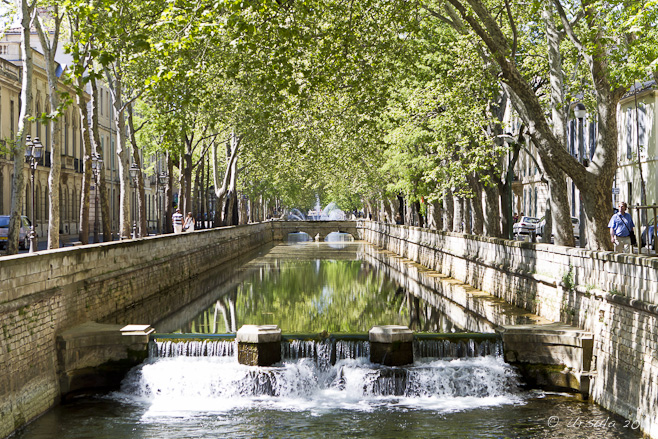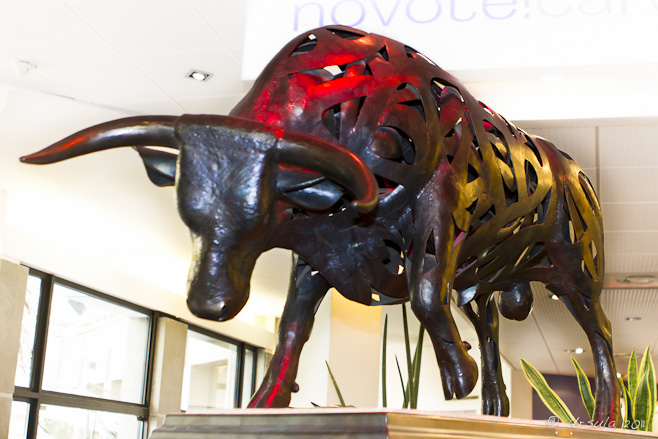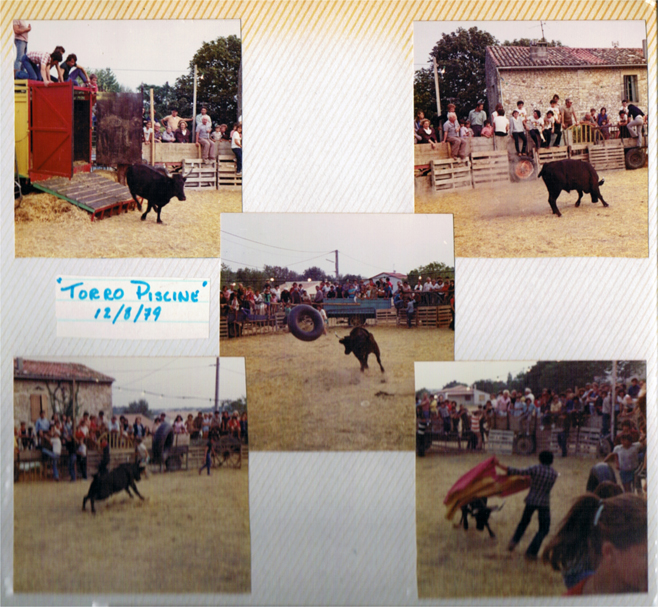
Avenue Jean Jaures
Nîmes gets its name from Nemausus, a Celtic god who was worshiped at the local spring. Les Quais de la Fontaine, the embankments of the spring, were laid out in the 1700s.
It’s autumn in Australia at the moment, which makes me think of spring in the Northern Hemisphere. Defies logic, I know, but there is something about the freshness of the air this change-of-season that has me humming: “I love Paris in the springtime…” and thinking of my last time in France, back in the spring of 2011, which is when we stopped for a day in Nîmes.
I’d been to Nîmes before: while I was a University student in Western Canada, I spent a summer working for friends who had bought an Auberge (country inn) in Gard, just outside this ancient southern city. I remembered it for it’s well-preserved Roman ruins, it’s cicadas, and its dry, shimmering heat.
I also remember it’s preoccupation with bulls.

Toro Miura qui Possede un Coeur ~ Miura Bull who Has a Heart
Lucien Blanc
That summer in Gard was the first (and only) time-and-place I attended a bull fight. Not the ‘glamourous’ Spanish fights with fancy toreadors in tight black pants, sparkly gold boleros, and red capes; no – more a ‘rodeo’ variety in a make-shift pen, with bull-fighters with pink and yellow capes that reminded me of cheap raincoats.

“Torro Piscine”
Bull Ring ~ Scanned photographs from a rustic bullfight near Nîmes, south of France, 1979.
It was a very long time ago, and I was keen to see if the city could live up to my distant memories of it. We were on our way to the start of our second walk in the French Pyrenees, travelling south from the Auvergne, so Nîmes was the perfect place to stop over. I booked a room close to the train station, and we set out with a city map, for a walk.

Le Palais de Justice
Inspired by La Maison Carrée, the Nimes Law Courts were built between 1836-1846 by architect Gaston Bourdon.

Life in the Palazzo

Les Arènes de Nîmes
Nîmes’ elliptical amphitheatre, built around 70 AD, is the best-preserved Roman arena in France.

Port de France
Locals go about their business through one of the two remaining gates from the original Augustine ramparts.

Modern Urban
Fresh paint and posters set off the old walls in the narrow streets.

L’Eglise St Paul
Decorated in Roman provençal style, St Paul’s Church was inaugurated in 1849. Following periods of change, Nîmes had become the major metropolis of Bas-Languedoc by the 19th Century.

La Maison Carrée
Built of local limestone by architects from Rome around 20 BCE, The Square House was designed by Marcus Vipsanius Agrippa, who was responsible for the Pantheon in Rome.

La Maison Carrée
The temple was originally dedicated to Gaius and Lucius, adopted sons of Augustus. It is one of the most beautiful and best preserved temples in the former Roman Empire.

Emperor Antonin (86 – 161)
Nîmes was part of the Roman empire from 118 BCE, and made a “colony” by Augustus in 27 BCE.

Avenue Jean Jaures
Leading into the Jardins de la Fontaine.

Jardins de la Fontaine ~ The Gardens of the Fountain
Built in the middle of the 18th century, the gardens effectively protect two major Roman ruins.

Fresh Green
The trees in the garden are wearing their spring finery.

The gardens are home to ancient statues …

… and living art.

Temple de Diane
My favourite ruin, possibly because it is less well-preserved, is the Temple of Diana. Some say it was built as a sacred fountain dedicated to Nemausus during the time of Augustus. Others say it was built in the 2nd century as a library.

Inside the Temple

Ancient Pillars

Temple of Diane
Fragments of delicately carved stonework remain.

Spring Blooms
Trees and bushes with these purple pea-like flowers were everywhere in the south.

La Tour Magne
It’s a short walk up the hill from the gardens to the La Tour Magne.

La Tour Magne ~ The Great Tower
Once part of the old ramparts.

The top storey has disappeared, but the tower still rises to a height of about 32m.

Nîmes
A climb up the insides of La Tour Magne afford a great view over the city.

The old olive tree and other vegetation at the base of the tower give an indication of the dry heat I remember so vividly from my earlier visit. Even though it was still spring, the day was hot and clear.

Les Arènes de Nîmes
During the Middle Ages, the arena was used as a fortress – a refuge for the population in case of danger. It was later filled with private houses, until the nineteenth century. Today, the amphitheatre is used for bullfights, music concerts. and other events.

Les Arènes de Nimes
Inside the corridors of the arena, it is easy to imagine the ancient battles. The lion’s cages, and a chapel for the gladiators are all here.

Modern “Bull Fight”
We were lucky enough to be visiting during one of the two annual bull festivals: “La Primavera des Aficionados” (Spring of the Fans). Julie Donzala demonstrates her skills.

Hot Pink
There are the capes of my memory!

Fortunately, the only “bulls” we saw were papier-mâché and wood on wheels.

Boy Toreadors
Young lads waiting for their turn with the “bulls”.

This horse is being dressed for it’s role as a picador in a fight with real bulls.

Cavalier
One of la cavalerie de Philippe Heyral.

The Arena
It’s a quiet afternoon in the stands.
 Nîmes was still hot. It was still preoccupied with bulls. And the Roman ruins were still fabulous.
Nîmes was still hot. It was still preoccupied with bulls. And the Roman ruins were still fabulous.
I didn’t hear any cicadas, but it was only April…
It was good to be back.
Pictures: 09April2011







































.png)


How amazing and what history… were you a history buff before travelling or has it inspired you? thanks as always for sharing your travels.
Hi Signe,
Thanks for visiting. Actually, most history bored me to tears at school, and I struggled to remember all the requisite dates. When I first went to England, however, I was captivated by the history in the very stones and walls of the buildings. And the gossip! All those plots and feuds!! Nothing like they taught us at school. 😉
[…] far-flung as South Wales (i.e.: Caerleon – watch this space!) and the south of France (see: Ancient History: Nîmes) and Spain (see: Layers: Cartagena and Málaga) brings history to life, and makes me marvel at the […]